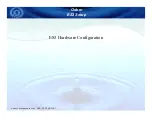
5
HGF Series Service Procedure
Preparation
Make your troubleshooting easier by preparing as
follows:
• work in a clean, well-lighted place;
• have proper tools and materials nearby:
• have a space set aside where you can lay components,
parts, and tools; and
• have an adequate supply of clean petroleum-based
solvent.
WARNING: SINCE THEY ARE FLAMMABLE, BE
EXTREMELY CAREFUL WHEN USING ANY SOLVENT.
EVEN A SMALL EXPLOSION OR FIRE COULD CAUSE
INJURY OR DEATH.
WARNING: WEAR EYE PROTECTION AND BE SURE
TO COMPLY WITH OSHA OR OTHER MAXIMUM AIR
PRESSURE REQUIREMENTS.
Preliminary Checks
For all their complexity, hydraulic systems are often
trouble-free.
The steer ing problem an operator
complains of could be caused by something other than
the hydraulic components.
Thus, once you have determined the problem and test
driven the vehicle (if possible), start with the easy-to-
check items.
On some vehicles, the conditions of the tires, especially
on the steered wheels, may affect steering. Make sure
pressures are at manufacturer's specifications. Make
sure tires are balanced and that they show no signs or
damage or severe wear. Check that they are mounted
properly.
Check steering and front end linkage. Broken, loose, or
binding parts could cause certain steering problems.
See if something in the steering column is loose or
binding.
If belts are present, check all of them. A tight belt could
also be glazed and a slipping belt doesn't always squeal.
In addition, the following could also contribute to a
steering problem:
• an overloaded vehicle;
• parts damaged from impact not properly repaired, or
that should have been replaced; and
• improper replacement parts.
Hydraulic Components
If you think the problem is caused by a hydraulic
component, start by checking the easy-to-reach items.
Check all hoses and lines for cracks, hardening, or other
signs of wear. Reroute any usable hoses that are kinked,
severely bent, or that rest against hot engine parts. Look
for leaks, especially at couplings. Replace any hoses or
lines that don't meet system flow and pressure ratings.
Next, go to the reservoir and filter or filters. Check fluid
level and look for air bubbles. Examine the filter; if it's
clogged, follow manufacturer's instructions for cleaning or
replacing it. A filter with a minimum 25 micron filtration is
recommended for the HGF system.
Visually check other components to see if they are
loosely mounted, show signs of leaks, or other damage
or wear.
It may be necessary that you perform hydraulic tests on
the pump and other hydraulic components. To do so,
consult the manuals published by the vehicle or
component manufacturers.
Troubleshooting Guide
NOTE:
Before troubleshooting a steering problem, check service literature published by the
vehicle and component manufacturers. Follow their instructions, if given, for
checking any component but the HGF Hydraguide unit.
Содержание Hydraguide HGF Series
Страница 45: ...HGF Series Service Procedure Notes ...










































